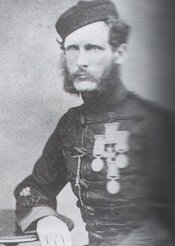Stephen Garvin facts for kids
Quick facts for kids
Stephen Garvin
|
|
|---|---|

Colour Sergeant Stephen Garvin
|
|
| Born | 1826 Cashel, County Tipperary |
| Died | 23 November 1874 Chesterton, Cambridge |
| Buried |
St. Andrew's Parish Churchyard, Chesterton
|
| Allegiance | |
| Service/ |
|
| Years of service | 1844–1863 |
| Rank | Colour Sergeant |
| Unit | 1st Battalion 60th Rifles |
| Battles/wars | Second Anglo-Sikh War Indian Mutiny North-West Frontier |
| Awards | Victoria Cross Distinguished Conduct Medal |
Stephen Garvin was a brave soldier born in Cashel, County Tipperary, Ireland, in 1826. He is famous for receiving the Victoria Cross. This is the highest award a soldier can get for showing amazing courage in battle. It is given to British and Commonwealth forces. Stephen Garvin also received the Distinguished Conduct Medal. He passed away on November 23, 1874.
A Heroic Act
Stephen Garvin was about 31 years old. He was a colour-sergeant in the 1st Battalion of the 60th Rifles. This was part of the British Army.
His brave act happened during the Indian Mutiny. This was a big rebellion in India. On June 23, 1857, in Delhi, India, he showed incredible bravery.
The Battle of Delhi
During the fighting, enemy soldiers were in a place called the "Sammy House." They were firing heavily at the British guns. This made it very dangerous for the soldiers.
Colour Sergeant Garvin bravely volunteered to lead a small group of men. Their mission was to go under heavy fire to the "Sammy House." Their goal was to remove the enemy soldiers from that spot.
After a tough fight, Garvin and his team succeeded. They drove the enemy out of the "Sammy House." This heroic action helped the British forces greatly. He was also praised for his courage throughout the entire battle in Delhi. For this, he was awarded the Victoria Cross.
Later Life and Burial
Stephen Garvin died in Chesterton, Cambridge, England. This was on November 23, 1874. He is buried in the St. Andrew's Parish Churchyard there.
His Victoria Cross medal is now owned by a private collector. A British politician named Lord Ashcroft bought it at an auction in 2014.

